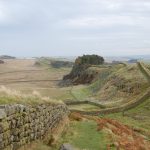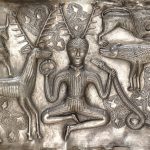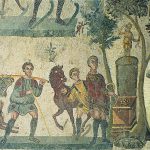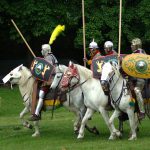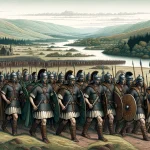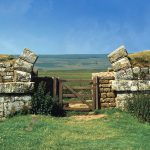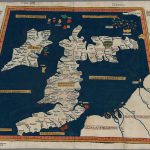Chester (Deva) Roman Fortress
Legionary Fort and Major Settlement
The Roman military presence at Chester probably began with a fort or marching camp at the mouth of the Deva Fluvius (River Dee) very likely established during the early campaigns of governor Publius Ostorius Scapula against the Deceangi in north-east Wales sometime around 47/48AD. There is some evidence of pre-Flavian occupation, possibly even a timber-built fort, but proof positive of a Scapulan foundation has yet to emerge.
After the first tentative forays of Scapula, the next military activity in the area was conducted during the early administration of governor Sextus Julius Frontinus sometime around 74AD when an auxiliary fort was constructed at Chester. The placement of this fort was a strategic move by Frontinus designed both to block the route of any routed British bands trying to escape to the north, and also to guard against any help arriving from the Brigantes .
By 79AD the site had developed into the twenty-five hectare fortress base of Legio II Adiutrix Pia Fidelis. The external dimensions of the fortress were 1,950 x 1,360 feet (594 x 415 m), which, allowing for the width of the defences gave an interior area of about 56 acres (22.7 ha). This early Flavian timber fortress is evidenced by lead piping bearing the name of Agricola .
Deva Victrix / Castra Legionis Victorious Deva / Fortress of the Legion
Classical References to Deva
There is an interesting paragraph in the second century geographical treatise by Claudius Ptolemaeus which says: “From these (the Ordovices) toward the east are the Cornavi, among whom are the towns: Deva, Legio XX Victrix 17*30 56? Viroconium 16*45 55?”. The Ordovices were a savage tribe from the valleys of North Wales, against whom the legionary fortress at Chester was directed. The extract shows that the prata legionis, the surrounding land which came under military jurisdiction of the Twentieth Legion stationed at the Deva fortress, was appropriated from the tribal territories of the Cornovii, whose cantonal capital lay at Viroconium Cornoviorum (Wroxeter, Shropshire).
Chester also appears in two (out of fifteen) routes in the Antonine Itinerary, produced in the late second century. The first mention is in Iter II, “The route from the ‘Entrenchments’ to the Port of Rutupiae“, which details the Roman road-stations between Hadrian’s Wall and the main port of embarkation for the continent at Richborough in Kent. On this route, Chester appears as Deva Leg XX Vict, which again confirms that the Twentieth Legion were garrisoned here, 20 miles from Condate (Northwich, Cheshire) and 10 miles from Bovium (Tilston, Cheshire).
One of the most interesting routes in the Itinerary is Iter XI, entitled “the route from Segontium to Deva“, this seventy-four mile long route features Chester as one of its termini. Iter XI is discussed in the RBO page for St. Asaph, the last but one station, which lies 32 miles from Chester.
It seems likely that the Chester fortress was abandoned by the legions sometime in the fourth century, as there is no mention of Deva in the Notitia Dignitatum published around the turn of the fifth. The town is mentioned in the seventh century Ravenna Cosmology (R&C#86), appearing as Deva Victris, between the unknown towns Saudonio and Veratino.
Roman Lead Piping Naming Governor Julius Agricola
“Imperator Vespasian nine times and Imperator Titus seven times consul.¹ For Gnaeus Julius Agricola,² pro-praetorian legate of the emperor.”
(Burn 27; RIB II; dated: 79AD)
- The emperor Titus Flavius Vespasianus and his like-named eldest son were ordinary consuls together for the last time from January 1st 79AD (a.u.c.832). Titus was entitled Caesar at the start of this year and became Imperator upon the death of Vespasian on 23rd June.
- The propraetor Agricola governed Britain from 77-83AD.
Around 87AD the Second ‘Assistant’ Legion was withdrawn from Britain by the emperor Domitian to be used in his wars in Dacia, and to replace them at Chester Legio XX Valeria Victrix were forced to abandon their newly-built fortress at Inchtuthil on the Tay, and were withdrawn from Scotland in order to maintain a strong legionary presence outside North Wales.
The fortress was rebuilt in stone c.102AD, during the reign of Trajan. These defenses consisted of a massive stone wall, fronted by a double ditch and backed by a rampart of sand and clay. Antonine pottery of c.170 confirms occupation in the latter half of the second century. Further reconstruction is recorded on an inscription of Elagabalus (c.235) and repairs were made to the fortress wall c.301-306. By 383 the silting up of the river Dee was a major factor in the abandonment of the Deva Fortress.
A large amphitheatre outside the south-east corner of the fortress could seat eight thousand people. Recent excavations conducted on the site have revealed that the amphitheatre was preceded by a bath-house.
The Soldiers’ Diet at Deva
The basic staple of the Roman soldier was bread, and each soldier was allocated about three pounds of corn per day in order to make a nourishing type of wholemeal loaf. When in garrison at the fortress, legionaires also ate a considerable quantity of meat. During excavations over the years at Chester many bones of animals and birds and the shells of molluscs have been uncovered, proving that the soldiers had a very healthy diet. The animal bones included those of domesticated Ox, Sheep, Goat and Pig, also game animals such as Red Deer, Roe Deer, and Boar, which were very likely being hunted and killed for sport. The bones of wild and domesticated fowl included those of Chicken, Duck, Goose, Pheasant and Swan. The main types of seafood consumed were Oysters and Mussels.
Epigraphic Evidence from Deva
“The Twentieth Legion. [Property] of Julius Candidus.”
There are over 120 inscribed stones recorded in the R.I.B. for Chester, including; 18 altarstones to assorted gods (discussed separately below), 5 building inscriptions, 2 cohort and 6 centurial stones, and 5 unclassified. However, by far the most evidence has come in the form of tombstones, 94 of which have been recorded in total (a selection of which are shown below).
The Gods of Roman Chester
RIB 445 - Altar dedicated to Fortune the Home-Bringer, Aesculapius, and Salus
To Fortune the Home-Bringer, to Aesculapius, and to Salus the freedmen and slave-household of Titus Pomponius Mamilianus Rufus Antistianus Funisulanus Vettonianus, son of Titus, of the Galerian voting-tribe, imperial legate, gave and dedicated this.
[...]ESCVLAP ET SALVTI EIVS
LIBERT ET FAMILIA
[...] P[...]ṂPONI T F GAL MAMILIAN[...]
RVFI ANTISTIANI FVNISVLAN[...]
VETTON[...]ANI LEG AVG
D D
Huebner (CIL) dates the lettering on the Chester stone to the end of the second century, but Haverfield (EE) questions this. Atkinson (JRS xii (1922) 65) interprets leg. Aug. as governor and dates him within a.d. 103 and 109; but Birley (in Askew, The Coinage of Roman Britain (1951) appendix I) does not include him in his list of governors. Collingwood (RBES (ed. 2, 1937) 120 n. 1) dates the lettering to the first half of the second century, and interprets leg. Aug. as legionary legate (so also Syme, JRS 47 (1957) 132 n. 7); he regards him as a brother or relative of, if not identical with, the Mamilianus who was a friend of the younger Pliny and consul in A.D. 100.Groag (PIR² note to F no. 570) assumes without question the identity of the Chester Mamilianus with the suffect consul of A.D. 100. Observe that, a generation later, T. Pomponius Antistianus, legate of Lycia-Pamphylia (IGRR iii 739, 14) and suffect consul in A.D. 120, has a nomenclature identical with the Chester one with the one exception of Mamilianus. This absence, however, might not exclude an identification of the Chester commandant with the consul of A.D. 120.See RIB 1879 for a Funisul[an]us Vetto[ni]anus as trib. coh. I Dac. on the third-century altar from Birdoswald.
There are eighteen known altarstones or dedicatory inscriptions to pagan gods recorded in Roman Chester, all of which are shown on this page. The deities best represented are the Genii or ‘guardian spirits’, of which there are six dedications, three to the genii centurionum or ‘the spirits of the centuries’ (vide RIB 446, 447 & 448), and other stones dedicated to ‘the spirit of the Twentieth Legion’ (RIB 449), ‘the genius of the standards of the Twentieth Legion’ (451) and another to the genius locum or ‘the spirit of this place’, this last one shared with the Numen Augusti or ‘the Living Spirit of the Emperor’ (450). The Numen Augusti is also celebrated on two more altarstones (458, 459). The only other deities to whom more than one altarstone is dedicated, each having two, are the god Jupiter (452, 453) and the mother goddesses (455, 456). Aside from the altarstone shared between Fortuna and Aesculapius (RIB 445), there are in addition five stones dedicated to individual deities; Mars Conservator (454), Minerva (457), Nemesis (573b), ‘the Nymphs and Springs’ (460), also one in Greek dedicated to Soter (461).
Altars Dedicated to the Genii or ‘Guardian Spirits’
GENIO SANCTO CENTVRIE AELIVS CLAVDIAN OPT V S:
“To the guardian spirit of the century, Aelius Claudian, optio¹, fulfills his vow.”
GENIO LEG XX VV D T VET:
“To the genius of the Valiant and Victorious Twentieth Legion, the veteran Decimus Titianus [dedicates this].”
GENIO SIGNIF LEG XX V V T FL VALERIANVS COLLEGIS D D:
“To the guardian spirit of the standards (or standard-bearers) of the Twentieth Legion, Valiant and Victorious, Titus Flavius Valerianus donated this offering for the brotherhood [of Signiferi].”
GENIO SANCTO CENTVRIE AELIVS CLAVDIAN OPT V S:
(RIB 448; altarstone)
GENIO LEG XX VV D T VET:
(RIB 449)
GENIO SIGNIF LEG XX V V T FL VALERIANVS COLLEGIS D D:
(RIB 451)
Altars to Three Deities Whose Names Begin With ‘M‘
DEO MARTI CONSERV …TVS …:
“To the god Mars the Preserver […]”
DEAE MATRIB DONVM:
“For the Mother Goddesses, a gift.”
DEAE MINERVAE FVRIVS FORTVNATVS MAG P V S:
“To the goddess Minerva, Furius Fortunatus the district magistrate¹ fulfils his vow.”
DEO MARTI CONSERV …TVS …:
(RIB 454; altarstone)
DEAE MATRIB DONVM:
(RIB 456; altarstone)
DEAE MINERVAE FVRIVS FORTVNATVS MAG P V S:
(RIB 457; altarstone)
- The inscription has been expanded MAG[ister] P[agi].
RIB 458 - Dedication-tablet
To the Divinity of the Emperor … had this set up in accordance with his vow.
ALMAECERT [...]
NVS ACT COR[...]
[...]
EX VOTO FACI[...]
For this interpretation of Numini Aug(usti) in the singular (following Horsley’s reading) see note to RIB 152.3. While act. could represent act(arius), act. cor. seems to be an impossible combination R.P.W. 4. About 10 letters deleted from the extant portion. This was presumably the title of a unit derived from an emperor whose memory was later condemned.
RIB 461 - Altar dedicated to the Saviour Gods
To the mighty Saviour Gods I, Hermogenes, a doctor, set up this altar.
[...]ΗΡΣΙÎ
ΥΠΕΡΜΕÎΕΣΙÎ
ΕΡΜΟΓΕÎΗΣ
ΙΑΤΡΟΣ ΒΩΜΟÎ
ΤΟÎΔ ΑÎΕΘΗΚΑ
Hermogenes was presumably a medicus in leg. XX V. V. Addenda from RIB+add. (1995): Birley People, 89, notes that Hadrian’s doctor was called Hermogenes (Dio 69.22); but the name is common.
RIB 463 - Fragmentary inscription
… and for the Emperor Titus Caesar … and for Caesar Domitian, son of (Vespasian) Augustus ..
[...]O CA[...]
[... ] DOMỊ[...]
The restoration here proposed would fit Vespasian and his two sons in A.D. 79, before his death on 24 June. This would agree with the date on the water-piping (EE ix 1039) installed at the completion of the fortress.
RIB 464 - Inscription
The Emperor Caesar Nerva Trajan, Augustus, conqueror of Dacia, son of the deified Nerva, ..
NE[...]
D[...]
The inscription seems to have recorded the rebuilding in stone of the defences of the fortress under Trajan.The left-hand fragment was found in 1884. The right-hand fragment, though probably found at the same time, is not given in Williams Inscr. (of 1886). But the small fragment, W 8.89 cm × H 15.24 cm m, which Williams figures, with part of a, m, or v, probably formed part of m in l. 1, but has not been recorded since then. Addenda from RIB+add. (1995): 3. Since d[…], let alone D[ac(icus)], is far from certain, a Hadrianic date is quite possible.
The Roman Military at Deva Victrix Castra Legionis
The legionary garrison of the Deva fortress left ample epigraphic evidence of their occupancy over the years. As you would expect, the legion which occupied the fortress for the greatest length of time left the most evidence. The Twentieth Legion is represented on 5 altarstones and 28 tombstones, the Second Legion Adiutrix appears on 11 tombstones, and there is a single tombstone of a soldier from the Second Augustan Legion.
Legio Vicesimae Valeria Victrix The Twentieth Legion, Valiant and Victorious
RIB 452 - Altar dedicated to Jupiter Tanarus Optimus Maximus
To Jupiter Tanarus, Best and Greatest, Lucius Elufrius Praesens of the Galerian voting-tribe, from Clunia, princeps of the Twentieth Legion Valeria Victrix, willingly and deservedly fulfilled his vow in the consulship of Commodus and Lateranus.
Ḷ [...] GALER
PRAESENS [...]VNIA
PRI LEG XX V V
COMMODO ET
LATERANO COS
V S L M
Clunia, in Hispania Tarraconensis.The princeps of a legion followed the primus pilus in order of seniority.Consulship of Commodus and Lateranus: A.D. 154; L. Aelius Aurelius Commodus was L. Verus (joint emperor 161-9).For Tanarus compare deo Taranucno CIL xiii 6478 (ILS 4624), CIL ibid. 6094 (ILS 4625); Iovi Taranuco CIL iii 2804 (ILS 4623); Taranis ara Lucan Phars. i 446. Addenda from RIB+add. (1995): For photographs of all four faces, and a discussion of the cult of Tanarus/Taranis, see Green, Chester ASJ 2nd Ser. 65 (1982), 37-44 with Pls. 1-2.
Thanks again to Terry Walsh for help with this translation.
The legion most readily associated with Chester is Legio Vicesimae Valeria Victrix, who occupied the fortress from c.88AD until the late-fourth century. They were not the original occupants of the Chester fortress, however, having replaced the Second Adiutrix. The evidence for this legion is great, with at least 28 tombstones of former sodiers and five inscribed altarstones dedicated by officers from the legion; three to various genii or guardian spirits (vide RIB 449, 450 & 451 supra), the obligatory altar to Jupiter Best and Greatest by a chief centurion (vide supra), and another dedicated by (or on behalf of) the entire legion to the ‘Nymphs and Springs’ (vide infra).
RIB 460 - Altar dedicated to the Nymphs and Fountains
To the Nymphs and Fountains the Twentieth Legion Valeria Victrix (set this up).
In this area springs of excellent water are known. It is probable that this altar marked the source from which Roman Chester drew its water-supply. Addenda from RIB+add. (1995): Despite Hanshall’s circumstantial account in Gent. Mag. loc. cit., there is a drawing of this altar by William Latham dated 16 June 1816 in the Lancashire Record Office (DP 292/44).
- ‘Prefect of the Camp’, the most prestigious legionary appointment for a long-serving centurion. The office was responsible for the day-to-day running of the fortress, also the provision of foodstuffs, building materials and military hardware.
- The titles of this man are:
- Emeritus – simply, a veteran soldier.
- Augur – a member of an extensive priesthood who, by looking into the entrails of sacrificial victims, could predict the answer to a simple question asked of the gods.
- Optio – second in command of a century, deputy to the centurion.
- Brixellum was a town in northern Italy where the emperor Otho committed suicide, now Bressello near Mantua. Equally however, the home town of this legionary may have been Brixia, now Brescia, an Italian town from beyond the Po, north of Cremona.
- The beneficiarii were soldiers exempt from normal duties in order to serve in some specialised capacity, in this case attached to the personal staff or bodyguard of the legionary legate.
Legio Secundae Adiutrix The Second ‘Assistant’ Legion
RIB 482 - Funerary inscription for Voltimesis Pudens
Voltimesis Pudens, son of Gaius, of the Sergian voting-tribe, from Augusta, trooper of the Second Legion Adjutrix Pia Fidelis, aged 32 years, of 13 years’ service, lies buried here.
ESIS ▸ PVDENS G ▸ FIL
SER ▸ AVGVSTA ▸ EQ
VES ▸ LEG ▸ II AD ▸ P ▸ F
ANNORVM ▸ XXXII
S
2. Augusta is Augusta Praetoria (Aosta). As CIL iii p. 73 assigns Augusta Alexandria Troas to tribus Aniensis, Ritterling, Westd. Zeitschr. 12 (1893) 107 n. 11 seems to be mistaken in making this Augusta Troas. Addenda from RIB+add. (1995): Birley (loc. cit.) notes that this Italian legionary would have been enrolled in A.D. 70, quite likely by Agricola himself.
RIB 478 - Funerary inscription for Gaius Valerius Crispus
To Gaius Valerius Crispus, veteran from the Second Legion Adjutrix Pia [Fidelis …
CRISPO
VETRANO
EX LEG II
AD PIA
[...]
No commentary.
The Second Legion Adiutrix are thought to be responsible for the original timber-built fortress at Chester, arriving in the area c.79AD and remaining on station for only a decade before being withdrawn from Britain by the emperor Domitian for use in his Dacian wars, wherupon they were replaced by the Twentieth. The Second Adiutrix is attested on at least 11 tombstones recovered from the Deva environs, some of which are shown here.
RIB 479 - Funerary inscription for Quintus Valerius Fronto
Quintus Valerius Fronto, son of Quintus, of the Claudian voting-tribe, from Celea, soldier of the Second Legion Adjutrix Pia Fidelis, aged 50, of 2[5] years’ service [… lies here].
VS Q F CLA
FRONTO CELE
A MILES LEG
II AD P F AN
NORVM L
STIPENDIORV
M XXṾ[...]
3. Celea, or usually Celeia, a municipium in Noricum. The numerals stating his years of service are damaged, but they probably ranged between 25 and 29. Forni, Il Reclutamento delle Legioni da Augusto a Diocleziano (1953) pp. 142-4 gives instances of soldiers who exceeded the normal term of 25 or 26 years. Birley loc. cit. shows that he was transferred from another legion.
RIB 476 - Funerary inscription for Gaius Juventius Capito
Gaius Juventius Capito, (son) of Gaius, of the Claudian voting-tribe, from Aprus, soldier of the Second Legion Adjutrix Pia Fidelis, in the century of Julius Clemens, aged 40, of 7 (or 17) years’ service [lies here].
G CLA CAPITO
APRO MIL LEG II
AD P F 𐆛 IVLI CLE
MENTIS ANN XL
STIP [...]VII
For Aprus see RIB 475.2. The omission of f(ilius) after G(ai) is not uncommon at Chester and elsewhere, and seems to be a variation without significance.
Legio Secundae Augusta The Second Augustan Legion
Other Military and Civilian Tombstones
Aside from two texts which are unclassified in the RIB (532 and 557), all of the inscriptions in the table below are from tombstones recovered from the Chester environs.
- A beneficiarius tribunis was a soldier on the personal staff or bodyguard of the military tribunes in the legion.
- A turma is a cavalry troop, numbering between 30 and 40 mounted troopers; there were around 120 cavalrymen in each Roman legion, organised into 3 or 4 turmae.
References for Deva Victrix / Castra Legionis
- The Roman Inscriptions of Britain by R.G. Collingwood and R.P. Wright (Oxford 1965);
- The Romans in Britain – An Anthology of Inscriptions by A.R. Burn (Blackwell, Oxford, 1969);
- The Roman Military Diet by R.W. Davies in Britannia ii (1971) pp.122-142;
- A Bronze Skillett-handle from Chester by J.C. McPeake & C.N. Moore in Britannia x (1978) p.329;
- Chronology of the Ancient World by E.J. Bickerman (Thames & Hudson, London, 1980);
- The Chester Gladiator Rediscovered by R. Jackson in Britannia xiv (1983) p.87;
- An Italian Legionary at Chester by Eric Birley in Britannia xiv (1983) p.252;
- Roman Chester by T.J. Strickland (Chester City Council, 1986, 2nd Imp.);
- Roman Britain – A Sourcebook by S. Ireland (Routlege, New York, 1986);
- Chester: The Canabae Legionis by D.J.P. Mason in Britannia xviii (1987) p.143;
- The Use of Earthenware Tubes in Roman Vault Construction: An Example from Chester by D.J.P. Mason in Britannia xxi (1990) p.215;
- Chronicle of the Roman Emperors by Chris Scarre (Thames & Hudson, London, 1995);
Map References for Deva Victrix / Castra Legionis
NGRef: SJ 404 662 OSMap: LR117
Roman Roads near Deva Victrix / Castra Legionis
Iter II: King Street: ENE (17) to Condate (Northwich, Cheshire) NNW (19) to Meols (Birkenhead, Merseyside) NE (19) to Wilderspool (Cheshire) Itinera II & XI: S (2) to Heronbridge King Street: ENE (17) to Nantwich
Sites near Chester (Deva) Roman Fortress
- Via Devana -The Chester Road (Margary 71,1g,1h,6a,19,24, 57a,57b) (1 km)
Roman Road - Heronbridge (3 km)
Major Settlement - Hoole Temporary Camp (3 km)
Marching or Temporary Camp - Upton-by-Chester Marching Camp 6 (3 km)
Marching or Temporary Camp - Upton-by-Chester Marching Camp 3 (3 km)
Marching or Temporary Camp - Pipers Ash, Guilden Sutton 3 Temporary Camp (3 km)
Marching or Temporary Camp - Upton Grange Moat Temporary Camp (3 km)
Marching or Temporary Camp - Upton-by-Chester Marching Camp 2 (3 km)
Marching or Temporary Camp - Upton-by-Chester Marching Camp 1 (4 km)
Marching or Temporary Camp - Guilden Sutton Camps (4 km)
Marching or Temporary Camp
